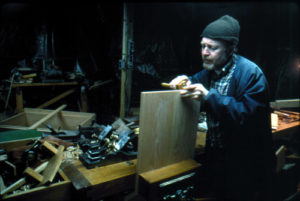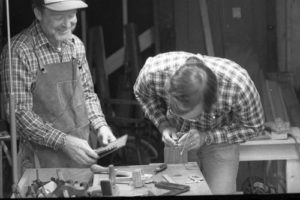James Price
b. 1944
Naylor, Missouri
Wood Joinery
Dr. James Price grew up watching his father make ax handles, gun ramrods, sassafras boat paddles, cedar turkey calls and furniture. Dr. Price wrote in 1985, “Woodworking was important on our Ozark farm. My family owned a small sawmill which produced lumber for use on the farm. We built buildings, repaired wagons, made furniture and boat paddles, and many other objects and structures of wood.”
A joiner, as well as an anthropologist/archaeologist, James Price learned joinery from his father, Acel W. Price, from Doniphan, Missouri, and Bruce Debo of Devil’s Elbow, Missouri. Dr. James Price is a sixth generation Ozark dweller and descendent of Current River Valley settlers who came to the region in 1814.
While he specialized in making boxes and chests, James Price’s 1986 lesson plans included the exploration of “the philosophy of why we should construct something by hand in the machine age.” According to outside evaluator Donald Love in May of 1986, Dr. Price’s lessons with Nick Heatherly included “a constant barrage of encouragement, criticism, praise, teasing, coaxing. Jim seems to have spared no effort to find minor stratagems for raising Nick’s curiosity and determination.”
The careful process of creating useful art is important to Dr. Price. During an outside evaluation in May, 1988, Dr. Price told Dr. Erika Brady, “Without using any fossil fuel source, I can take a pile of boards and make them into an object of beauty. The tools are the instrument, and the piece becomes a kind of permanent music. If it doesn’t burn or blow away, it can last a thousand years—it will be impossible to pull apart.” His joy in creating functional, beautiful, and high quality art put him in high demand as a teacher.
Dr. Price’s enthusiasm for joinery works well with his love of teaching. In a January 1986 letter to MFAP staff, Dr. Price enthused, “Nick and I drove his chest together on Sunday. All 52 dovetails and 54 pins matched exactly!! Nick had a real case of the nerves since one wrong saw cut or too tight a fit would have meant disaster. We are both delighted with the progress we have made.”
According to Brady, “Price explained that his selection of apprentices is based in his perception of their interest and commitment, demanding physical activity in their spare time. In addition, they must be able to make use of the best resources and materials available, without shortcuts.” His care in choosing an apprentice was also reflected in his skill as a teacher. Dr. Price’s apprentices universally praised his skill and teaching ability. His apprentice in 1992, Tom Blair, told MFAP staff, “James Price is extremely knowledgeable and skilled in hand tool wood working…I would like to someday pass these skill on to my son and possibly teach these skills to other people as Mr. Price will have taught me.”
Apprentices:
1986 Nick Heatherly
1987 Bernard Allen
1988 Christopher Miller
1989 Debra Hunt
1992 John (Tom) Blair
Audio clip: James Price describes the joy of rehabilitating old tools and “making them sing again” during a site visit to his Naylor, Missouri workshop on November 11, 1985.


